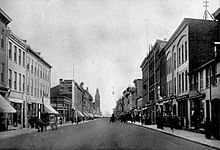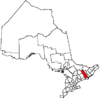
The Bay of Quinte is a long, narrow bay shaped like the letter "Z" on the northern shore of Lake Ontario in the province of Ontario, Canada. It is just west of the head of the Saint Lawrence River that drains the Great Lakes into the Gulf of Saint Lawrence. It is located about 200 kilometres (120 mi) east of Toronto and 350 kilometres (220 mi) west of Montreal.

Leamington is a municipality in Essex County, Ontario, Canada. With a population of 29,680 in the Canada 2021 Census, it forms the second largest urban centre in Windsor-Essex County after Windsor, Ontario. It includes Point Pelee National Park, the southernmost point of mainland Canada.

Aurora is a town in central York Region in the Greater Toronto Area, within the Golden Horseshoe of Southern Ontario, Canada. It is located north of the City of Richmond Hill and is partially situated on the Oak Ridges Moraine. In the Canada 2021 Census, the municipal population of Aurora was the 92nd largest in Canada, compared to 95th for the 2016 Census and 97th for the 2006 Census. Aurora is twinned with Leksand, Sweden.

Newmarket is a town and regional seat of the Regional Municipality of York in the Canadian province of Ontario. It is part of Greater Toronto in the Golden Horseshoe region of Southern Ontario. The name stems from the fact that the settlement was a "New Market", in contrast to York as the Old Market.

Whitby is a town in Durham Region. Whitby is located in Southern Ontario east of Ajax and west of Oshawa, on the north shore of Lake Ontario and is home to the headquarters of Durham Region. It had a population of 138,501 at the 2021 census. It is approximately 45 km (28 mi) east of Toronto, and it is known as a commuter suburb in the Durham Region, east of the Greater Toronto Area. While the southern portion of Whitby is predominantly urban and an economic hub, the northern part of the municipality is more rural and includes the communities of Ashburn, Brooklin, Myrtle, Myrtle Station, and Macedonian Village.

Hastings County is located in the province of Ontario, Canada. Geographically, it is located on the border of Eastern Ontario and Central Ontario. Hastings County is the second-largest county in Ontario, after Renfrew County, and its county seat is Belleville, which is independent of Hastings County. Hastings County has trademarked the moniker "Cheese Capital of Canada".

Tillsonburg is a town in Oxford County, Ontario, Canada with a population of 18,615 located about 50 kilometres southeast of London, on Highway 3 at the junction of Highway 19.

Prince Edward County (PEC) is a county in southern Ontario, Canada. Its coastline on Lake Ontario’s northeastern shore is known for Sandbanks Provincial Park, sand beaches, and limestone cliffs. The Regent Theatre, a restored Edwardian Opera House, sits at the heart of the town of Picton on the Bay of Quinte. Nearby Macaulay Heritage Park highlights local history through its 19th-century buildings. In 2016, Prince Edward County had a census population of 24,735. Prince Edward County is a city, single-tier municipality and a census division of the Canadian province of Ontario.
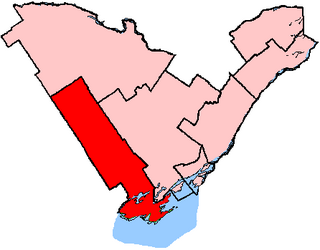
Prince Edward—Hastings was a federal electoral district in Ontario, Canada, that existed in the House of Commons of Canada from 1968 to 2015. Its population in 2006 was 113,227. It was redistributed between Bay of Quinte electoral district and Hastings—Lennox and Addington electoral district as a result of the Canadian federal electoral redistribution, 2012.

Quinte West is a city, geographically located in but administratively separated from Hastings County, in Southern Ontario, Canada. It is on the western end of the Bay of Quinte on Lake Ontario. The Lake Ontario terminus of the Trent–Severn Waterway is in the municipality.

Lakeshore is a municipality on Lake St. Clair, in Essex County, Ontario, Canada. It was incorporated in 1999 by amalgamating the Town of Belle River with the townships of Maidstone, Rochester, Tilbury North, and Tilbury West. It is the largest and the most populous municipality within Essex County. However, it is part of the Windsor census metropolitan area.
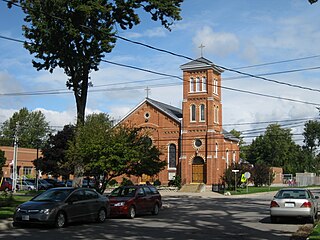
Dunnville is an unincorporated community located near the mouth of the Grand River in Haldimand County, Ontario, Canada, near the historic Talbot Trail. It was formerly an incorporated town encompassing the surrounding area with a total population of 12,000.

Woodbridge is a large suburban community in Vaughan, Ontario, Canada, along the city's border with Toronto. It occupies the city's entire southwest quadrant, west of Highway 400, east of Highway 50, north of Steeles Avenue, and generally south of Major Mackenzie Drive. It was once an independent town before being amalgamated with nearby communities to form the city in 1971. Its traditional downtown core is the Woodbridge Avenue stretch between Islington Avenue and Kipling Avenue north of Highway 7.

Bolton is an unincorporated town that is the most populous community in the town of Caledon, Ontario, Canada, in the Regional Municipality of Peel. It is located beside the Humber River, approximately 50 kilometres northwest of Toronto. In regional documents, it is referred to as a 'Rural Service Centre'. It has 26,795 residents in 9,158 total dwellings. The downtown area that historically defined the village is in a valley, through which flows the Humber River. The village extends on either side of the valley to the north and south.

Dorchester is a town in Ontario whose name first applied to the township and honours Sir Guy Carleton, Lord Dorchester (1724-1808). The name was changed from Dorchester Station on May 3, 1961. Dorchester is the residential and commercial core of the municipality of Thames Centre, in Southwestern Ontario, Canada, a few kilometres directly east of the city of London, Ontario. According to the 2016 census, the town has a population of 3,911.
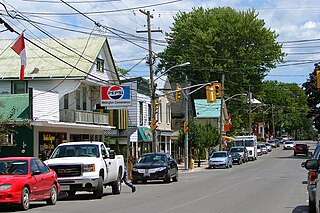
Wellington is an unincorporated place and community in Prince Edward County in eastern Ontario, Canada. It has a population of 1,932 according to the 2016 Census. The community is located on the shore of both Lake Ontario and West Lake in the southwest of the county. Sandbanks Beach, the northernmost of Sandbanks Provincial Park's beaches, is located in the Village of Wellington, where it is called Wellington Rotary Beach.

The Toronto Patriots are a junior "A" ice hockey team from Toronto, Ontario, Canada. They are a part of Ontario Junior Hockey League.

Deseronto is a town in the Canadian province of Ontario, in Hastings County, located at the mouth of the Napanee River on the shore of the Bay of Quinte, on the northern side of Lake Ontario.
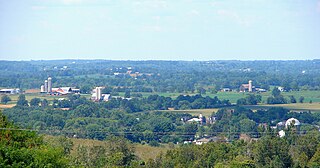
Stirling-Rawdon is a township in the Canadian province of Ontario, located in Hastings County. It was formed on January 1, 1998, through the amalgamation of Rawdon Township with the Village of Stirling. Stirling was named the 2012 Kraft Hockeyville winner, after gaining more than 3.9 million votes.

Bay of Quinte is a federal electoral district in central Ontario, Canada, centred on the Bay of Quinte.



